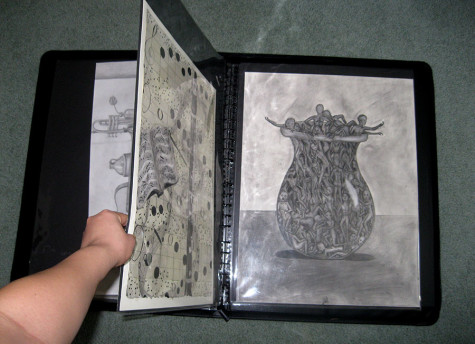What not to include in a college art portfolio
February 11, 2015
[cincopa AQFAzOM5Ufci]
The Scientific Method to an Art Portfolio
What benefit can an art portfolio supplement add to your college application? For students who plan on continuing art in college, an art portfolio may be required. Fortunately, these portfolio deadlines are often later than Early Action and Regular Decision deadlines.
Students who wish to pursue other areas in college may strongly benefit from submitting an art portfolio supplement. Even if you don’t plan on pursuing an art major or minor, an art portfolio will show colleges creativity, unique thought processes, and a side that otherwise wouldn’t be portrayed.
Lina Pepper, an art teacher at HBHS, understands the benefits of an art portfolio. “An art portfolio shows students are capable of skills, talent, flexibility, attention to detail, and potential.” For those who are artistic, an art portfolio may give an edge in admissions and scholarships. “An art portfolio can certainly help students who are going to college for any field. I had a student who was going for architecture and her portfolio helped get her in even though she was doing a different type of work. It showed she was conscientious and creative,” says Pepper.
How do you create a great art portfolio? The most important part is planning ahead. Get started on pieces during Sophomore and Junior year. This is the time to experiment with new media, techniques, and subjects. Senior year, as you bring together all of your pieces, take inventory of your art. Pieces you’ve created in art classes are important to include in your portfolio, but should not make up the majority of your submission. Colleges want to see that you are motivated to do art outside of a structured class.
Although it varies by college, plan on having 15 to 20 pieces in your final portfolio. You can include one sketch in your portfolio, but limit it to only one high quality sketch. A portfolio is like a final draft of your work. Include a wide range of subject matter and media so that colleges can see depth.
Wook Choi, the author of Art College Admissions : An Insider’s Guide to Art Portfolio Preparation, Selecting the Right College, and Gaining Admission with Scholarships, says “By demonstrating technical proficiency across a wide range of medias in your art portfolio, your work will convey that you’ve cemented a solid foundation understanding of basic art principles.”
Do not mail in your artwork, even if a college says that it is strongly recommended. Your artwork could be lost in the mail or delayed so that you do not have it in time for your interviews. It is better to bring it when you visit the college and that way you are there to discuss and explain your artwork to the reviewer. Invest in a portfolio so that you can bring your artwork to college interviews and portfolio review days.
Photographing artwork creates a better contrast than scanning. Use a high quality camera to photograph your artwork. Go outside on a cloudy day and hang the art up. Take many photographs of each piece and later sort through them to find the best one. Keep in mind that pencil sketches are difficult to capture through photography, especially if they are lighter. Use a program such as Photoshop or Paint.net to fix the contrasts and colors and crop borders. Be sure not to exaggerate either. College reviewers will notice and it will detract from your portfolio. Depending on your budget, portfolios are available everywhere in stores ranging from a general craft such as Michaels to a high end art store like Dick Blick.
The best way to submit your art portfolio online may vary. The most common way is through Slideroom, where you can upload your art according to the specifications of each college. If the college does not use Slideroom than another way to submit a portfolio is by creating a website with sites such as Wix. Attach this link in your general application or email it to the admissions for each college.
An essential aspect of your art portfolio is an artist’s statement, of up to 2000 characters, that should accompany each piece. Describe your motivation behind each piece and any influences you pulled to create it. Come up with a title for each piece and include the dimensions and year. According to Choi, “Always favor quality over quantity” when choosing which pieces to put in. Pepper says “I think the hardest part of an art portfolio is deciding what to put in and leave out. Sometimes what you leave out is as important as what you put in.”
An art portfolio should not be done on a whim. It takes careful planning and time. If you believe that you have artistic talent that colleges should see, start your portfolio now. Want to see an example of a digital portfolio? Go to www.emilyraymond.wix.com/artportfolio to see this writer’s college portfolio website.

Photo Credit: Emily Raymond ‘15













